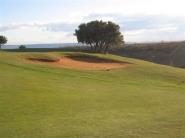Source:
Technical igK Dpt.
10 December 2013
Natural turfgrass surface: perennial grassland
Each turfgrass species has its own temperature range for maximum growth.
 Cubierta vegetal viva y perenne
Cubierta vegetal viva y perenne
They are adapted to a given climate zone when they are able to survive on their own for long periods of time. For simplicity's sake, turfgrass species comprising playing fields are divided into two large groups: Cool Season turfgrasses and Warm Season turfgrasses.
Cool Season Turfgrasses: These species develop better in temperatures between 61º and 75º F (16º and 24º C), while temperatures above 81º F (27º C) severely affect leaf and root growth. The common genera found in these conditions are Poa, Lolium, Agrostis and Festuca.
Warm Season Turfgrasses: These species develop best with air temperatures between 81º and 95º F (27º and 35º C). Growth ceases during prolonged exposure to temperatures below 50º and 55º F (10º and 13º C), the leaves slowly lose chlorophyll and the plant becomes dormant, turns brown, and recovers when the temperature rises above said levels. The genera found in these conditions are Cynodon (Bermuda), Paspalum, Zoysia, Stenotaphrum, Penisetum, Eremochloa, Buchloe and Axonopus. Generally these species adapt better when they are mowed shorter, develop a deeper root system and are more heat and drought resistant than the cool season turfgrasses.
Thus there is no perfect turfgrass, and so there are constant plant improvement programs for obtaining new varieties that require fewer resources. Some of the research programs conducted worldwide, include higher drought resistance, higher water and soil salinity tolerance, low fertilizer needs, adaptation to shady areas, shorter dormant periods, and better texture.
Several aspects need to bear in mind when choosing species and varieties for establishing a turfgrass surface that is adapted to the use requirements: temperatures, growth potential rate, precipitation, humidity, playing zone, soil type, water quality, micro climate, etc.
The first goal is the establishment and maintenance of the surface with the best quality and the fewer resources. The goal in terms of watering, when choosing the species and maintenance policy is to reduce evapotranspiration (ET) as much as possible so as to minimize irrigation requirements. This is an essential aspect for obtaining the desired level of the turfgrass quality.